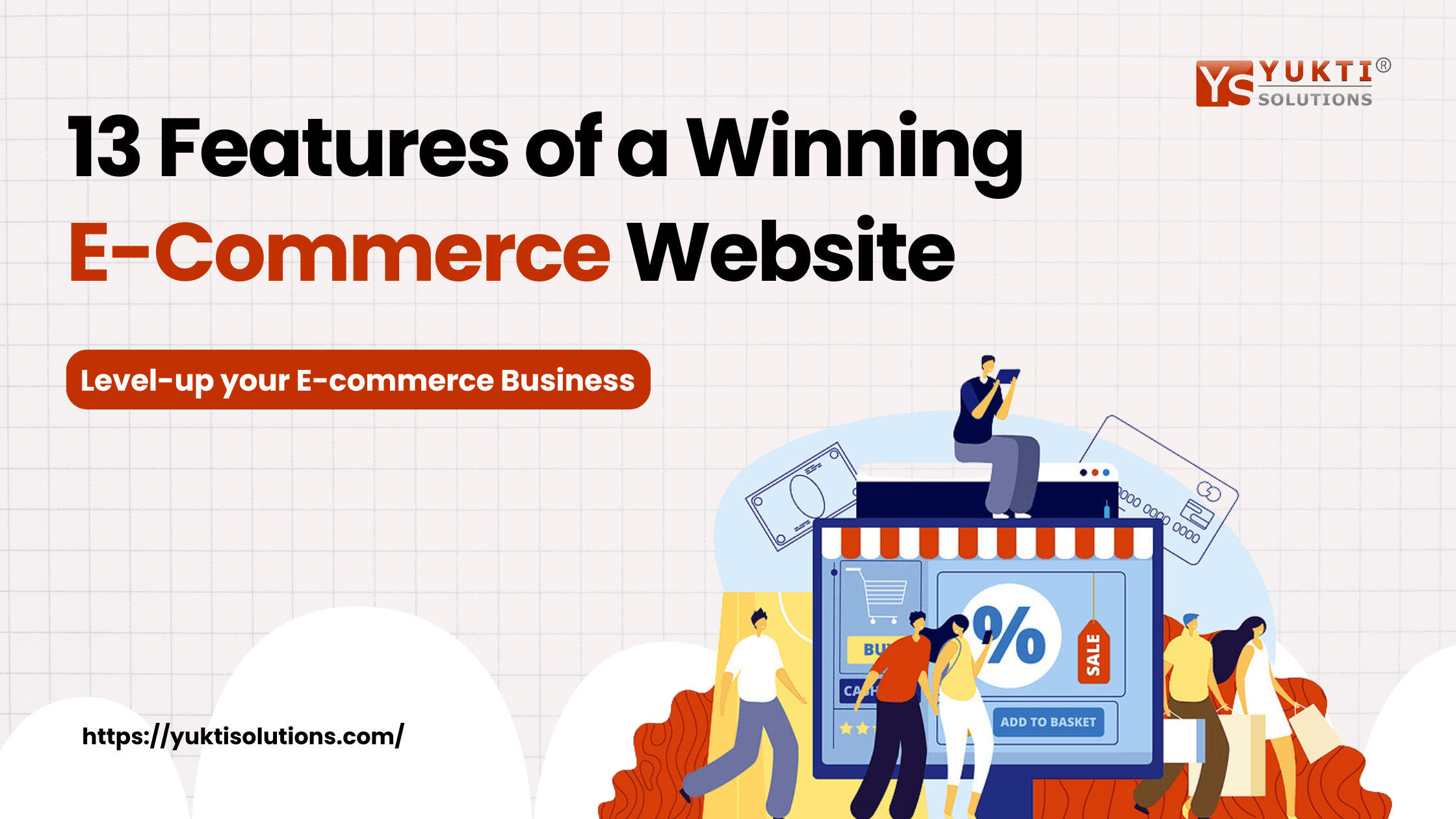13 Features of a Winning E-Commerce Website
13 Features of an Winning E-Commerce Website: · Feature #1. User-Friendly Navigation · Feature #2. High-Quality Product Pages · Feature #3. Streamlined Shopping Cart...

In today's digital age, online shopping has become a common part of our lives. Many of us have probably purchased something using our smartphones or computers without going to a store. Thanks to the internet and e-commerce, we are presented with a variety of options. This online shopping experience takes place on e-commerce websites or platforms, also known as electronic commerce platforms.
There are various e-commerce platforms or websites available today. For example, Amazon, Flipkart, Walmart, eBay, Alibaba, etc.
According to the research, worldwide e-commerce revenues will amount to $58.74 Trillion by 2028. It is quite clear that there is a huge opportunity in using online strategies, but you should also know that it is very competitive. In order to establish a successful e-commerce website, it is important to have a good grasp of consumer behavior, effective digital marketing campaigns, and a strong customer service infrastructure.
Hence, the main challenge lies in developing a trustworthy, easy-to-navigate, and customer-oriented platform that converts visitors into loyal customers.
That is why, to start, you should provide your website with a number of necessary features that can be considered the basis for a successful e-commerce business. Let's discuss the 13 main e-commerce website features that will transform your website from an online store into a winning e-commerce platform.
Feature #1: User-Friendly Navigation
A good website should have simple, effective, and efficient navigation that will send visitors to their products of interest without any struggle. You should have implemented the core essential elements that make a user-friendly website. It is recommended that you create a mega menu, which would serve as a one stop link to all the products and sub products. This enables them to easily browse through a list of multiple products without being stuck in a web of links.
Additionally, a breadcrumb, which is a line with the current section’s URL leading to the web site’s hierarchy, helps the user understand the current location of the website and makes it easy for the user to go back or move to wider categories.
Feature #2: High-Quality Product Pages
This is the second feature you should prioritize while creating your e-commerce business website. First impressions matter! Since there is no physical interaction with the buyer, the high quality product pages become the foundation for building trust and driving sales.
You must provide compelling product descriptions that clearly describe features, benefits, and specifications. But the effect of high quality visuals creates the most impact.
Use large and good quality images that display the products from all angles. Zooming in can also be considered an effective method to look into the product closely. Users prefer to zoom in on certain products, like clothing or shoes.
As for some products, 360° views can become exciting as they give users a sort of physical touch of the product.
Feature #3: Simple Shopping Cart and Checkout Process
A shopping cart should be easy to use for customers in order to ensure they have a positive experience. Make sure product details are visible within the cart—images, names, and quantity, to be precise. It allows a customer to change the quantity easily. In addition, it helps to show estimated shipping costs so that they do not shock the consumer.
A smooth and secure check-out process is a must-have. Maintain the minimum number of steps in the checkout process with precise guides available to customers. Credit cards, debit cards, and digital wallets are the most used payment methods by users across the globe. Thus, giving customers a payment choice makes the product buying process smooth.
Always bear in mind that speedy as well as safe checkout means more sales and happy customers.
Feature #4: Secure Payment Gateway
Security becomes important if a customer is dealing in online financial transactions. During checkout and purchase, a customer is required to input their card details. Here, building trust is essential. This is where a secure payment gateway comes into play. It also serves as armor that protects the passage of valuable information, such as credit card numbers, from leakage.
A few examples of some secure payment gateways are Stripe, PayPal, Razorpay, Amazon Pay, etc.
A credible payment gateway makes your customers information safe and secures you from fradulent activities. It shows your commitment to customer security and fosters trust in your brand.
Feature #5: Responsive Design
The time has passed since users explored the internet and online shopping websites only in desktop mode.
Modern customers are familiar with so many devices, like smartphones, laptops, tablets, and also desktops. To meet this growing demand, responsive website design is no longer an option but a necessity.
A responsive website design dynamically adjusts its layout and content in a way that fits the size and resolution of every device being used. This maintains the same feel and look of your website, whether a customer is using it on their morning commute or peacefully exploring your website from their couch.
Responsive design not only improves the user buying journey but also helps in better SEO and increased website traffic.
Feature #6: Inbuilt Search Functionality
Like Google Search, you should have built-in search functionality on your website. It helps customers easily find what they're looking for. It improves the shopping experience of a user.
It would be better to provide auto-complete suggestions as users type, saving them time and effort.
Apart from this, include a product filter that enables users to narrow down their search through options like brands, price level, or color. Thus, users can jump directly to the products they are interested in, which contributes to improving conversion.
Feature #7: Personalized Product Recommendations
In today's data-driven world, personalization is king. Based on the browsing history and actual purchase behavior of a customer, you can offer products relevant to their interests. This also enhances customers’ interest, and they might enjoy browsing your website. It brings new opportunities for upselling and cross-selling, resulting in boosting sales and the average order value.
Feature #8: Live Chat Support
Live chat support is a great way to have real-time communication with customers. It enables customers to get direct contact with a support representative within the website, and this can help answer questions, provide assistance for problems that customers are experiencing, and provide information on products.
It not only solves problems effectively but also helps with personalized service, customer satisfaction, and customer loyalty.
Feature #9: Clear Return and Refund Policy
Suppose, you ordered a dress from an e-commerce website and find out that it didn't fit or had a defect. A clear return and refund policy works as a backup, and customers will have confidence in your brand. It is always advisable to properly write down the terms under which returns are accepted, the period of return, and the mode of refund. Promote corrective actions.
Feature #10: Customer Reviews and Ratings
Customer reviews and ratings act as an important factor in finalizing a purchase decision.
It is a kind of social proof that gives potential customers the opportunity to see others’ experiences and decisions before making a purchase decision. However, customers are more likely to prefer social proof when buying their product. Therefore, reviews and ratings help build confidence in their intended product.
Positive reviews highlight product strengths and build confidence in your brand, while negative feedback can help you identify areas for improvement.
Feature #11: Email Marketing Integration
We can't forget the power of a well-drafted, personalized email for a business. Emails encourage long term customer relationships and drive sales. For e-commerce websites, it serves as a useful tool for driving conversions. Customers feel special and valued when they receive personalized emails that address their needs and preferences.
First Capture the leads through sign-up forms placed throughout your website. Once subscribed, nurture these relationships with targeted email campaigns segmented by interests or purchase history. This enables you to send promotional messages to customers with special offers and discounts, thereby making them buy your products more.
Feature #12: Targeted Promotions and Discounts
There is no doubt that promotional activities thought out in advance can be rather effective in forming consumer demand. Sending proper discount codes or coupons to customers who either frequently browse a certain category or have not bought a product in a long time encourages them to make a purchase.
Utilizing peak holiday and festival seasons with flash sales or coupons can create huge demand for products. Furthermore, the retargeting campaign through sending follow-up emails in the customer’s cart-vacation message offering the products’ discount can help to recover losses and refresh the customers about the product they wanted to purchase.
Feature #13: Order Tracking and Order History
Trust and transparency are the keys to success in the e-commerce world.
After a customer purchases a product, there should be a feature for order tracking, allowing the customer to track their product in real-time, ensuring peace of mind.
This can be done through integration with shipping carriers, providing an expected delivery date, and allowing a user to track the status of the product with a simple click. In addition, the order history of customers enables buyers to check past orders, return policies, and get the necessary information about the orders. It also helps your business get repeat business for the same products that a customer previously bought.
Conclusion:
In today’s competitive e-commerce market, it is evident that every e-commerce business needs a proper strategy that is aligned to its goals to shine and succeed. They should prioritize the customer experience, continuously upgrade themselves, and implement the latest digital marketing strategies.
Keep in mind that building customer trust and loyalty is essential for sustaining long-term success in the competitive marketplace. So, constantly update yourself and your brand with the latest e-commerce trends to stand out among competitors.
If you want to build an e-commerce website for your business, our team of e-commerce website developers is here to help you achieve your goals. We'll create a user-friendly, conversion-focused website that drives sales revenue and boosts your online presence. We'll help you implement all of the above features to streamline the shopping journey and increase your customer base. Let us convert your e-commerce website into a powerful sales engine.
